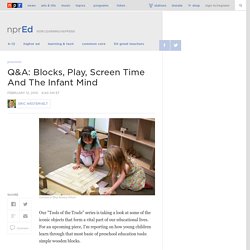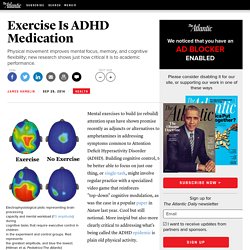

Q&A: Blocks, Play, Screen Time And The Infant Mind : NPR Ed. Courtesy of Bing Nursery School Our "Tools of the Trade" series is taking a look at some of the iconic objects that form a vital part of our educational lives.

For an upcoming piece, I'm reporting on how young children learn through that most basic of preschool education tools: simple wooden blocks. Dr. Dimitri Christakis has done extensive research on blocks and play, and has lectured on media and children. He is the director of the Center for Child Health, Behavior and Development at Seattle Children's Research Institute. We talked about the way young children learn and how their minds develop. Dr. Itoggle caption Courtesy of Dr. Se connecter à Facebook. TIMPANI toy study. Toys that Inspire Mindful Play and Nurture Imagination Play is the fundamental way children prepare for the future.

When children create a make-believe world, build a tower of blocks, or race a friend to the top of a hill, they acquire social and intellectual abilities needed to be successful in school and adulthood. Nearly all meaningful play includes toys. A single, engaging toy can transform a child's play from simple to symbolic, from repetitive to inventive, from solitary to social.
The Center for Early Childhood Education has a keen interest in studying how young children play. Nominate a Toy for an Upcoming Study We are now accepting nominations for the 2014 TIMPANI Toy Study. TIMPANI Toy for 2013 There was a tie for the highest-scoring toy in the 2013 study. Magna-Tiles by Valtech, LLC My First Railway by Brio. Exercise Is ADHD Medication. "If physical activity is established as an effective intervention for ADHD," they continued, "it will also be important to address possible complementary effects of physical activity and existing treatment strategies ...

" Which is a kind of phenomenal degree of reservation compared to the haste with which millions of kids have been introduced to amphetamines and other stimulants to address said ADHD. The number of prescriptions increased from 34.8 to 48.4 million between 2007 and 2011 alone. The pharmaceutical market around the disorder has grown to several billion dollars in recent years while school exercise initiatives have enjoyed no such spoils of entrepreneurialism. But, you know, once there is more research, it may potentially be advisable to consider possibly implementing more exercise opportunities for kids.
John Ratey, an associate professor of psychiatry at Harvard, suggests that people think of exercise as medication for ADHD. Exercise Is ADHD Medication. Mental exercises to build (or rebuild) attention span have shown promise recently as adjuncts or alternatives to amphetamines in addressing symptoms common to Attention Deficit Hyperactivity Disorder (ADHD).

Building cognitive control, to be better able to focus on just one thing, or single-task, might involve regular practice with a specialized video game that reinforces "top-down" cognitive modulation, as was the case in a popular paper in Nature last year. Cool but still notional. More insipid but also more clearly critical to addressing what's being called the ADHD epidemic is plain old physical activity. This morning the medical journal Pediatrics published research that found kids who took part in a regular physical activity program showed important enhancement of cognitive performance and brain function.
Earlier this month, another study found that a 12-week exercise program improved math and reading test scores in all kids, but especially in those with signs of ADHD. Watch "The Decline of Play and Rise of Mental Disorders: Peter Gray at TEDxNavesink" Video at TEDxTalks. School starting age: the evidence. Why so many kids can’t sit still in school today. The Centers for Disease Control tells us that in recent years there has been a jump in the percentage of young people diagnosed with Attention Deficit and Hyperactivity Disorder, commonly known as ADHD: 7.8 percent in 2003 to 9.5 percent in 2007 and to 11 percent in 2011.

The reasons for the rise are multiple, and include changes in diagnostic criteria, medication treatment and more awareness of the condition. In the following post, Angela Hanscom, a pediatric occupational therapist and the founder of TimberNook, a nature-based development program designed to foster creativity and independent play outdoors in New England, suggests yet another reason more children are being diagnosed with ADHD, whether or not they really have it: the amount of time kids are forced to sit while they are in school. This appeared on the TimberNook blog. Can Free Play Prevent Depression and Anxiety In Kids? Over the past 50-60 years, play time in kids’ lives has been drastically cut.

School days and years are longer and parents often schedule enrichment activities for their children instead of giving them space to direct their own play. Children are rarely given the freedom to direct their own activities, leading to a persistent rise in children feeling that they have no control over their lives. And, while correlation doesn’t prove causation, Dr. How Finland Keeps Kids Focused Through Free Play - Tim Walker.
Like a zombie, Sami—one of my fifth graders—lumbered over to me and hissed, “I think I’m going to explode!

I’m not used to this schedule.” And I believed him. An angry red rash was starting to form on his forehead. Yikes, I thought. What a way to begin my first year of teaching in Finland. Throughout this first week of school, I had gotten creative with my fifth grade timetable. I didn’t see the point of these frequent pit stops. Come to think of it, I wasn’t sure if the American approach had ever worked very well. Once I incorporated these short recesses into our timetable, I no longer saw feet-dragging, zombie-like kids in my classroom.
At first, I was convinced that I had made a groundbreaking discovery: frequent breaks kept students fresh throughout the day.